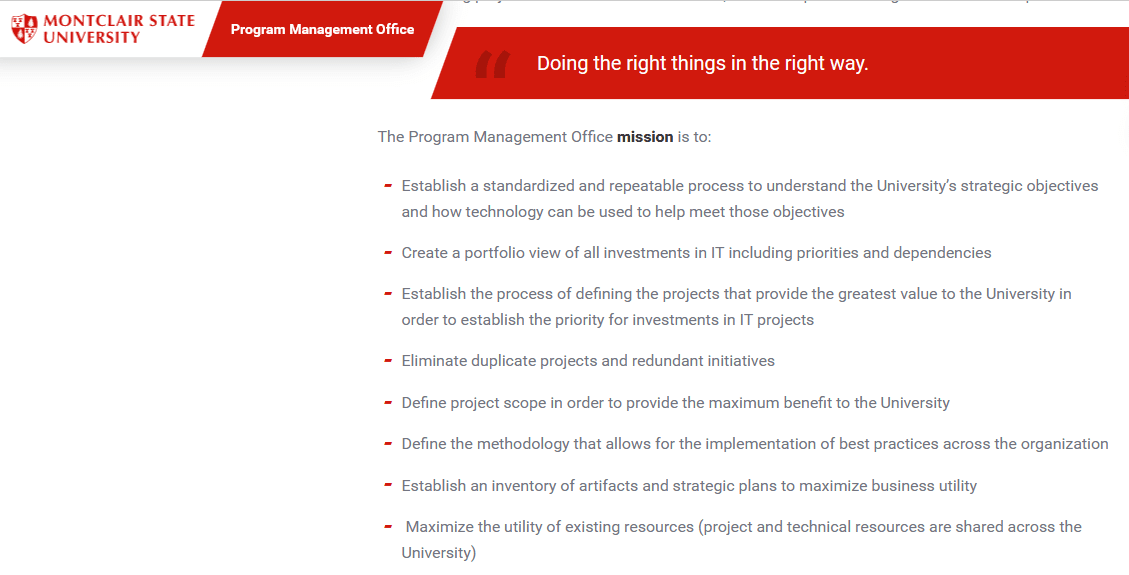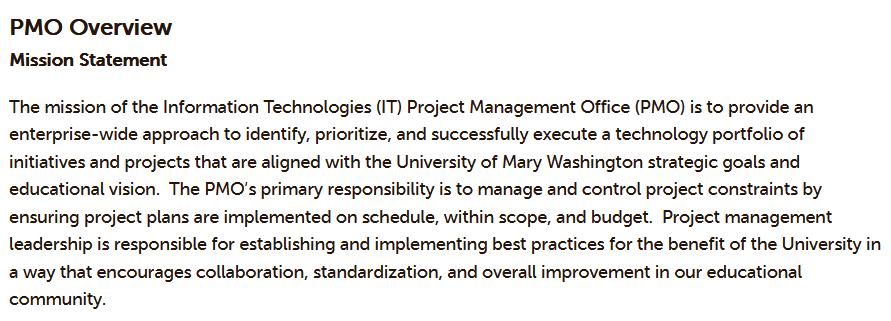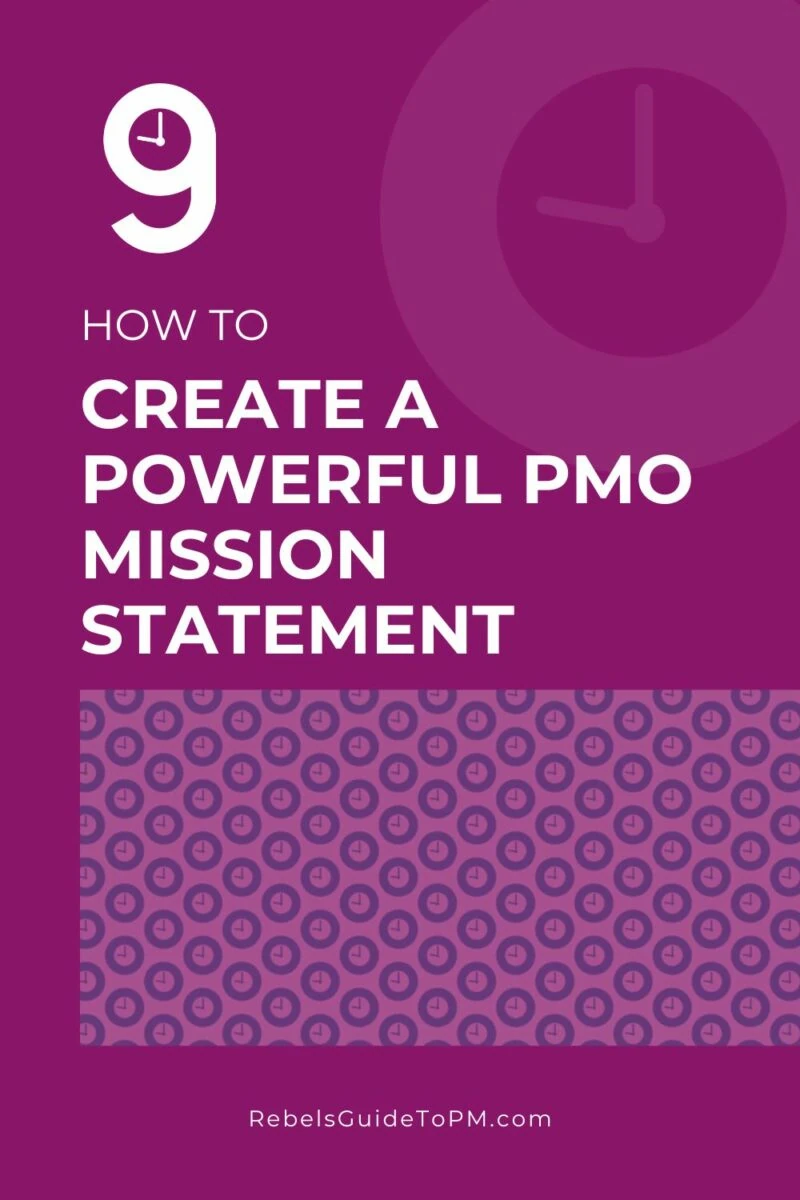How to Create a Powerful PMO Mission Statement
There’s a lot riding on getting your PMO mission statement right.
After all, the mission statement is what will guide the PMO as it strives to achieve its goals and objectives. Creating a powerful PMO mission statement doesn’t have to be difficult – but it does require some thought and careful planning.
Why have a mission statement for the PMO?
The PMO is responsible for ensuring that an organization’s projects are well-organized, well-run, and produce the desired results. A key part of a PMO leader’s job is to develop and maintain project management standards and processes and to support the people doing the delivery – project managers, program managers, and teams.
One way to easily explain what you do and why you do it is to create a mission statement for the PMO.
It should explain what the PMO does and why it exists. It also presents a vision of the future, what’s possible for the team, and where the PMO wants to be.
The mission statement should be easy to understand and should be aligned with the organization’s strategy.
Creating a mission statement for the PMO can help to:
- Define the role of the PMO in the organization
- Clarify the PMO’s purpose
- Communicate the PMO’s value to the organization – very important given that PMOs seem to come and go as a disposable asset in the business
- Guide the PMO’s decision-making process.
A well-crafted mission statement can be a powerful tool for the PMO. It can help to focus the team’s efforts and ensure that it is working towards the right goals.
And it’s a great communication tool to use with the higher-ups.
What goes into a mission statement?
Your mission statement is the foundation of your Project Management Office. It’s a guiding light that will help you make decisions, big and small.
So, what goes into a mission statement?
Your purpose
First, you need to identify your department’s purpose. Ideally you’d do this when setting up a PMO, but you can do it at any time.
Why do you exist?
What do you do?
What kind of PMO are you?
Perhaps you provide a document repository of project management templates. Perhaps you’re a supportive PMO that provides coaching and development to project teams. Perhaps your major role is advising upwards to provide a strategic overview of the portfolio.
Your values
Next, you need to think about your team’s values.
What do you believe in?
What guides your decisions?
Many companies already have corporate values that you can draw from. If you don’t have them, or they don’t seem relevant, you can co-create your own with the team.
Values are often single words like simplicity, productivity, trust, integrity, honesty and so on.
Your goals
Finally, you need to consider your department’s goals.
What do you want to achieve as a PMO?
What difference do you want to make to the organization?
For example, it could be:
- Improving project success rates
- Engaging customers
- Delivering innovative products on time, on budget
- Supporting the implementation of agile approaches across the organization.
Goals can change every year, so don’t worry about it. When you meet one, add another!
A goal statement helps you focus on what’s important, and it will guide you through tough decisions.
How mission statements link to PMO core values and vision
A mission statement is a reflection of the core values and vision of an organization. It is a brief statement that defines what the team does, its purpose, and its goals.
A mission statement should be clear, concise, and easy to remember. It should also be inspiring and motivating. Quite an ask!
An effective mission statement will guide the actions of the PMO and its members and help to focus and direct the team’s efforts while reflecting the PMO’s core values and vision.
The PMO’s mission statement should be reviewed and updated on a regular basis to ensure that it remains relevant and aligned with the organization’s values and vision.
Got all that? Great. Now you are ready to craft a mission statement that captures it all. Get it on a slide!
Example PMO mission statements
Montclair University
Montclair University has published their PMO mission on their website. Here’s an extract:
The Program Management Office’s mission is to:
- Establish a standardized and repeatable process to understand the University’s strategic objectives and how technology can be used to help meet those objectives
- Create a portfolio view of all investments in IT, including priorities and dependencies
- Establish the process of defining the projects that provide the greatest value to the University in order to establish the priority for investments in IT projects
Their full vision and mission statement is 265 words and well worth a read if you are looking for inspiration.

Ministry of Works, Government of Bahrain
The Ministry of Works has a website that doesn’t look like it is maintained in English any longer. But if you can get over the terrible clipart, there is a good section on the mission, vision, and goals of the PMO
As an example vision statement, here’s an extract from their page:
In everything we do, the PMO will:
- Be approachable
- Promote a culture where collaboration is a core value
- Be respectful of differing ideas and values
- Nourish a positive and supportive environment
- Be passionate about project management
- Support the Mission and Vision of the MoW [Ministry of Works]

State of Maine Office of Information Technology
Here’s another example from the PMO for the State of Maine’s IT division:
The Project Management Office (PMO) is a leader in establishing and implementing project management best practices that promotes effective and successful project outcome, increases efficiency, and ensures the successful delivery of projects that support State of Maine policy and program objectives.
The PMO’s mission is maximizing the value of State initiatives in the public interest through the successful implementation and management of best project management practices.
This is just an extract. There are 250 words outlining how the PMO supports customers; it’s really very good. And it shows an alternative format because it’s very actionable and not too heavy on values and blue-sky aspirations. So you could take that approach for your own team.

University of Mary Washington
Finally, here’s an example from the University of Mary Washington Information Technology department.
This is their vision statement as published on their website:
Vision Statement
- Support faculty, staff, students and the UMW community as a source for project management leadership and expertise
- Promote best practice standards, quality, and methodologies into a project management discipline
- Utilize PMBOK-based methodology as well as support ‘best fit’ approach for project management at UMW
- Provide a channel of communication for project status, financial health, and mitigation of issues, risks, and dependencies across projects, departments, and/or divisions
- Build project management maturity at the organization level

If you are looking for more examples, universities and government departments often publish their goals and mission statements, so start there with your search.
How to create a mission statement collaboratively with the team
Crafting a mission statement can feel like a daunting task, especially if you’re doing it alone. But it doesn’t have to be!
In fact, it absolutely should not be. In all the organizations I’ve worked in where the company wanted to refresh the values, it was a huge team effort. In one company, a team of leaders self-nominated themselves to take part in the exercise. They then sought input from a large group, then presented the findings to the exec.
I also remember consultants coming in to help craft company messaging at one point and the exec having a two-day offsite to try to finalize what we stood for.
It’s a big job.
If you involve your team in the process, you can come up with a statement that accurately reflects your company’s values and goals.
I wouldn’t recommend a two-day offsite for this exercise for your PMO. Just put half a day aside and see how you get on.
Here’s how to create a mission statement collaboratively with your team.
Step 1. Brainstorm values that are important to your company
Start by brainstorming a list of values that are important to your company. These can be values that you want to uphold in your portfolio management work, or they can be values that you want your team to be known for.
Some examples of values that you might want to include are:
- Quality
- Innovation
- Customer satisfaction
- Teamwork
- Integrity.
Step 2. Draft a mission statement that reflects these values
Once you have a list of values, you can start drafting a mission statement that reflects them. Keep it simple and to the point.
And make sure that everyone on your team agrees with the statement before moving on.
Step 3. Make it actionable
A good mission statement is not only a reflection of your company’s values, but it’s also actionable. In other words, it should guide the way you and your teamwork.
Step 4. Review and revise as needed
The mission statement now becomes part of your PMO Toolkit, one of the resources you can use regularly to communicate and bring people bck to the core mission of the team.
How to Set up a PMO Series
The first 30 days of your PMO: A week-by-week guide
Your PMO Toolkit: The essentials you actually need to set up a PMO
12-step checklist for setting up a PMO
How to write a PMO mission statement
How to structure and staff your PMO (without a big budget)
Once you have a draft of your mission statement, review it periodically to make sure it still accurately reflects your company’s values. And don’t be afraid to revise it as needed.
Creating a mission statement collaboratively with your team is a great way to ensure that it accurately reflects your company’s values. And it can help you and your team stay focused on what’s important.
Key takeaways
- A good mission statement should be reflective of the team’s values.
- It should be actionable – something you can live your work by.
- A mission statement should identify your team’s purpose, values, and goals.

